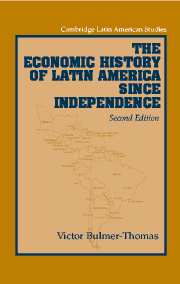Book contents
- Frontmatter
- Contents
- List of tables, figures, and maps
- Preface to the second edition
- Preface
- List of abbreviations
- 1 Latin American economic development: an overview
- 2 The struggle for national identity from independence to midcentury
- 3 The export sector and the world economy, circa 1850–1914
- 4 Export-led growth: the supply side
- 5 Export-led growth and the nonexport economy
- 6 The First World War and its aftermath
- 7 Policy, performance, and structural change in the 1930s
- 8 War and the new international economic order
- 9 Inward-looking development in the postwar period
- 10 New trade strategies and debt-led growth
- 11 Debt, adjustment, and the shift to a new paradigm
- 12 Conclusions
- Appendix 1 Data sources for population and exports before 1914
- Appendix 2 The ratio of exports to gross domestic product, the purchasing power of exports, and the volume of exports, circa 1850 to circa 1912
- Appendix 3 Gross domestic product per head, 1913, 1928, 1980, and 2000
- Bibliography
- Index
- CAMBRIDGE LATIN AMERICAN STUDIES
11 - Debt, adjustment, and the shift to a new paradigm
Published online by Cambridge University Press: 05 June 2012
- Frontmatter
- Contents
- List of tables, figures, and maps
- Preface to the second edition
- Preface
- List of abbreviations
- 1 Latin American economic development: an overview
- 2 The struggle for national identity from independence to midcentury
- 3 The export sector and the world economy, circa 1850–1914
- 4 Export-led growth: the supply side
- 5 Export-led growth and the nonexport economy
- 6 The First World War and its aftermath
- 7 Policy, performance, and structural change in the 1930s
- 8 War and the new international economic order
- 9 Inward-looking development in the postwar period
- 10 New trade strategies and debt-led growth
- 11 Debt, adjustment, and the shift to a new paradigm
- 12 Conclusions
- Appendix 1 Data sources for population and exports before 1914
- Appendix 2 The ratio of exports to gross domestic product, the purchasing power of exports, and the volume of exports, circa 1850 to circa 1912
- Appendix 3 Gross domestic product per head, 1913, 1928, 1980, and 2000
- Bibliography
- Index
- CAMBRIDGE LATIN AMERICAN STUDIES
Summary
The Mexican government's August 1982 threat of default on its external public debt was the trigger that finally unleashed the debt crisis. The net flow of bank lending to Latin America ground to a halt, and the net transfer of resources suddenly turned negative. Even countries like Colombia, which had been prudent about accumulating foreign-debt obligations, were affected as private financial institutions in the developed countries reversed their previously optimistic forecasts concerning Latin America.
The decline in bank lending set in motion a chain of events that was to lead by the end of the decade to a New Economic Model (NEM), based on exports, for the majority of republics. The transition to a new trajectory was not painless and was far from complete even in those countries that were prepared to carry out the most far-reaching program of reforms. Yet countries had few alternatives, for the logic of the situation demanded a response from governments all along the political spectrum. The old growth model, based on a central role for the state in the process of capital accumulation, was attacked on one side by the decline in capital flows to state-owned enterprises (SOEs) and on the other by the emerging consensus in favor of neoliberal economics and a smaller state.
The NEM emerged in part as a pragmatic response to the series of adjustment and stabilization programs adopted in each republic in the 1980s.
- Type
- Chapter
- Information
- The Economic History of Latin America since Independence , pp. 353 - 391Publisher: Cambridge University PressPrint publication year: 2003

